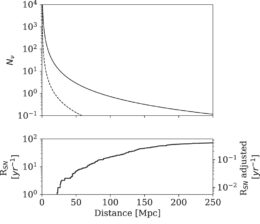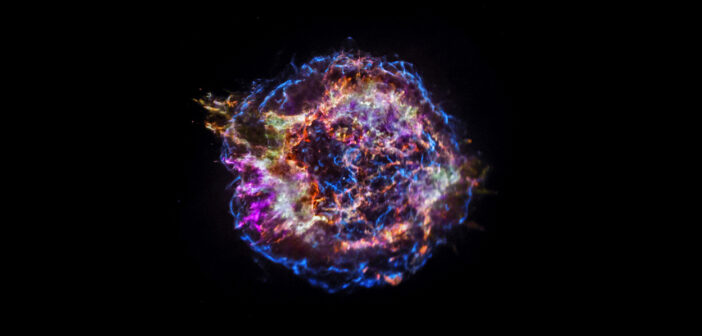Astronomers can get a better view of more distant supernova explosions by searching for high-energy neutrinos, according to a study conducted by researchers at Uppsala University in Sweden.
Detecting Ghostly Particles from Collapsing Stars

The IceCube Laboratory at the Amundsen-Scott South Pole Station in Antarctica. [Felipe Pedreros, IceCube/NSF]
There are various neutrino detectors scattered across the planet, including IceCube in Antarctica. It can detect the neutrinos produced by core-collapse supernovae, which typically have energies in the mega-electronvolt range. However, the way its detectors work means that supernova neutrinos from farther away than the Magellanic Clouds — the largest satellite galaxies of the Milky Way — are too faint for it to see.
Circumstellar Collisions and Choked Jets
Nora Valtonen-Mattila and Erin O’Sullivan (both Uppsala University) think that there may be higher-energy neutrinos on offer, which would extend that range to more than a hundred million light-years. That would include supernovae in many other galaxies and local galaxy clusters.
These neutrinos — in the giga- to tera-electronvolt range — aren’t produced by the supernova itself, though. Instead Valtonen-Mattila and O’Sullivan consider two alternative production mechanisms.
Before stars go supernova they tend to eject vast amounts of material in fierce stellar winds. When the supernova detonates, the debris from the explosion hits this circumstellar material. Protons collide like they do in particle accelerators here on Earth and should produce high-energy neutrinos in the process. However, these neutrinos have yet to be observed.
A similar thing could be achieved through a jet of material that becomes trapped behind the star’s outer shell. This is called a choked jet. Ordinary particles may be trapped, but neutrinos are famously ghost-like and can stream through dense material with ease. In fact, a light-year of lead would only have fifty-fifty chance of stopping a neutrino.

The predicted number of observable neutrinos in the northern sky based on the choked-jet model (top) for two detection methods. The bottom panel shows the cumulative number of supernovae observed by the Zwicky Transient Facility each year. [Adapted from Valtonen-Mattila and O’Sullivan 2023]
Expanding Our Horizons
It’s these high-energy neutrinos from choked jets that offer the greatest possible extension to IceCube’s range, pushing it out to 277 million light-years in the northern sky and 65 million light-years in the southern sky. However, choked jets are rare, with just 1–4% of core-collapse supernovae thought to have one.
These are important considerations, particularly in light of the ongoing upgrade to IceCube-Gen2, which should be completed by 2033. Perhaps then we’ll have a clearer picture of core-collapse supernovae and the neutrinos they produce.
Citation
“Prospects for Extending the Core-collapse Supernova Detection Horizon Using High-Energy Neutrinos,” Nora Valtonen-Mattila and Erin O’Sullivan 2023 ApJ 945 98. doi:10.3847/1538-4357/acb33f
